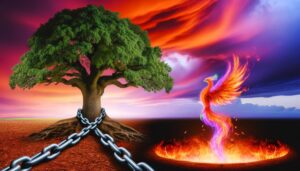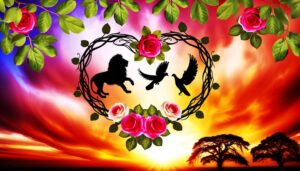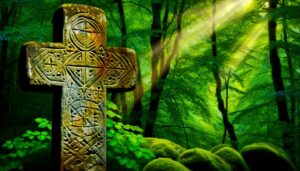Celtic Symbol for New Beginnings?
Celtic culture is rich with symbols that signify new beginnings, prominently featuring the Triskelion, Awen, and Druid's Knot. The Triskelion symbolizes progress, motion, and the cyclical nature of life, encompassing life, death, and rebirth.
Awen represents divine inspiration and creative renewal, deeply rooted in Druidic traditions. The Druid's Knot embodies renewal, harmony, and the interconnectedness of existence.
Each of these symbols reflects the perpetual cycles of growth and transformation fundamental to Celtic spirituality. Discovering how these symbols intertwine with personal and cultural renewal can offer a deeper understanding of Celtic beliefs.
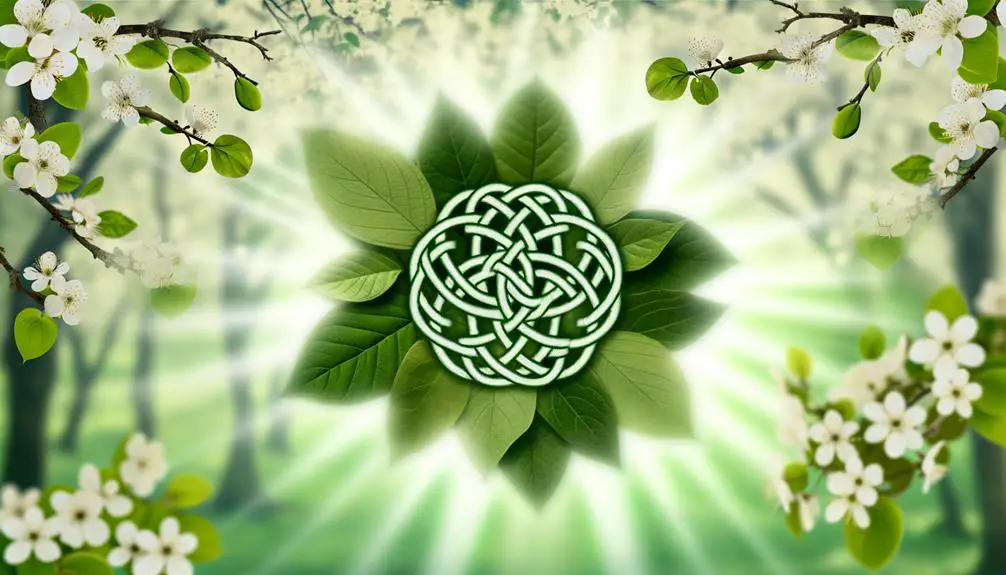
Key Takeaways
- The Awen symbolizes new beginnings through divine illumination and creative inspiration.
- The Butterfly represents personal rebirth journeys and evolving life phases in Celtic culture.
- The Spiral highlights life's ceaseless flow, growth, and perpetual transformations.
- The Triskelion embodies progress, motion, and the cycles of life, death, and rebirth.
- The Druid's Knot signifies renewal and harmony, reflecting cyclical existence and perpetual rebirth.
The Significance of Celtic Symbols
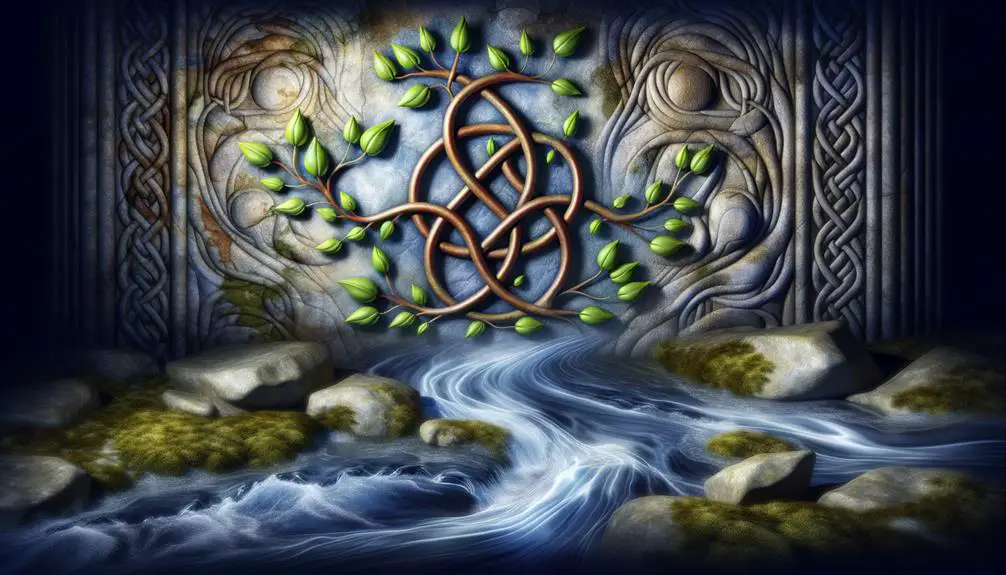
Understanding the significance of Celtic symbols requires delving into the rich tapestry of Celtic culture, where each symbol encapsulates profound meanings rooted in ancient traditions and beliefs.
The Celts, an ancient Indo-European people, intricately wove their spiritual and cultural ethos into their art and symbols. These emblems were not mere decorative motifs; they were imbued with deep symbolic significance, often representing themes such as the cyclical nature of life, interconnectedness, and spiritual growth.
Symbols like the Awen, the Tree of Life, and the Claddagh reflect complex concepts of harmony, unity, and eternal love. By studying these symbols, one gains insight into the Celts' worldview, where every design is a narrative of life's perpetual cycles and spiritual quests.
Triskelion: The Symbol of Progress
Often revered for its dynamic and intricate design, the Triskelion stands as a powerful Celtic symbol embodying the principles of progress, motion, and the perpetual cycle of life. Originating from ancient Irish and Breton cultures, the Triskelion features three interlocking spirals or legs, which represent balance and forward movement.
| Aspect | Representation |
|---|---|
| Three Spirals | Life, Death, Rebirth |
| Interlocking Design | Unity and Harmony |
| Circular Motion | Eternal Progress |
The Triskelion is often associated with the triadic nature of existence, such as earth, water, and sky or past, present, and future. Its continuous motion signifies an unending journey towards growth and evolution, reflecting the Celtic understanding of life's cyclical and ever-progressing nature.
Awen: Inspiration and Creativity
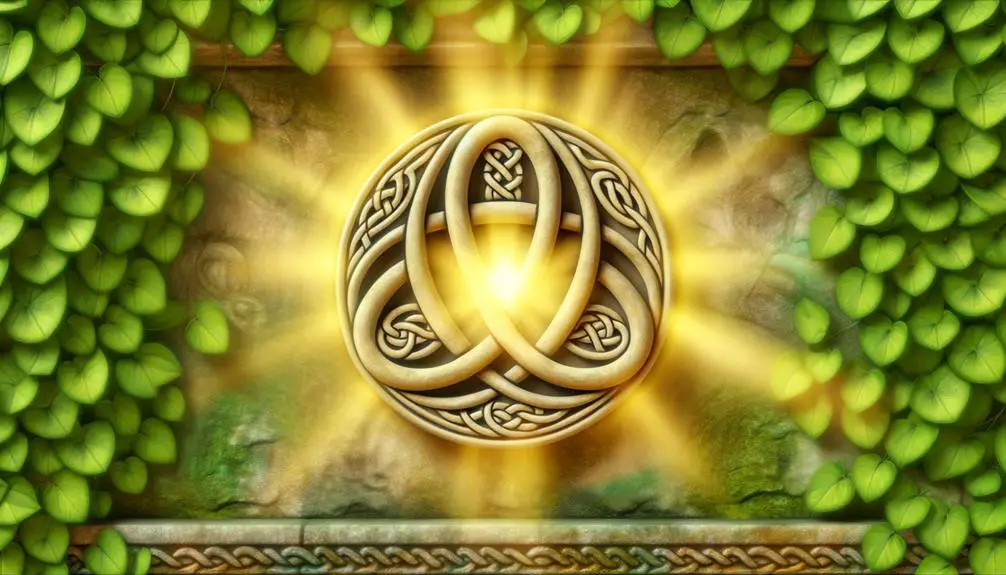
In the rich tapestry of Celtic symbolism, the Awen emerges as a profound emblem of inspiration and creativity, seamlessly complementing the Triskelion's emphasis on perpetual progress.
The Awen, often symbolized by three rays of light, represents divine illumination and the harmonious balance between male and female energies. Rooted in Druidic traditions, the term 'Awen' translates to 'flowing spirit' in Welsh, embodying an essential life force that fuels artistic expression and intellectual pursuits.
This symbol holds significant cultural importance, seen as a conduit for poets, musicians, and scholars to access deeper domains of insight and creativity. Through the Awen, individuals are inspired to initiate new ventures, reinforcing its role as a crucial symbol for new beginnings within Celtic lore.
Druid's Knot: Renewal and Harmony
The Druid's Knot, also known as the Shield Knot, stands as a powerful Celtic symbol representing renewal and harmony, intricately woven into the spiritual and cultural fabric of Druidic traditions.
Historically, the Druid's Knot was believed to offer protection and balance, its interlocking design symbolizing the interconnectedness of life and the cyclical nature of existence. This emblem was often inscribed on amulets and sacred spaces to invoke stability and spiritual rejuvenation.
In Druidic cosmology, the knot's unbroken loops signify the eternal flow of energy, reflecting the belief in perpetual rebirth and the harmonious balance of nature. Its enduring presence in Celtic art underscores its importance in rituals seeking renewal and a harmonious equilibrium, reinforcing the timeless values of Druidic spirituality.
The Green Man: Nature's Rebirth
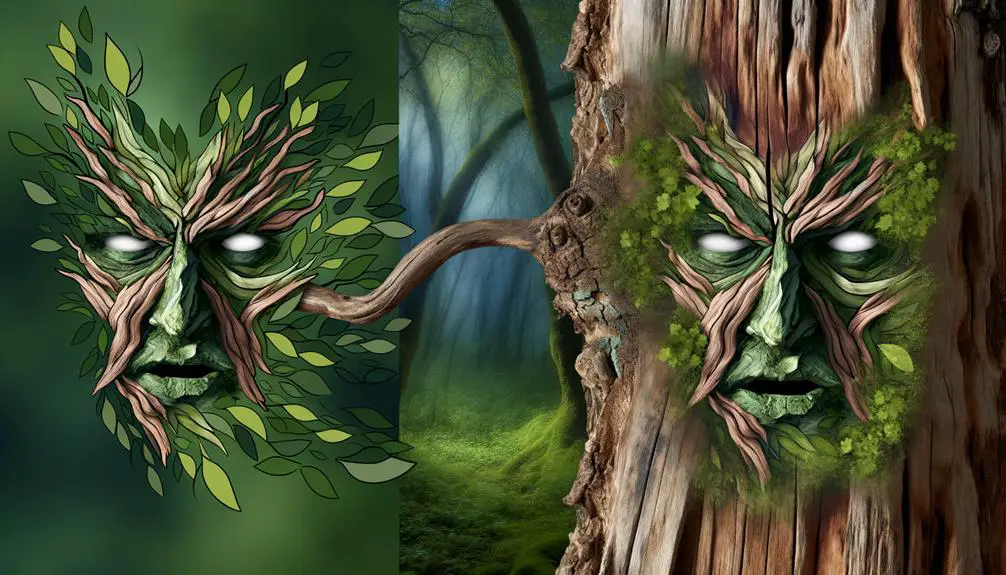
How does the enigmatic figure of the Green Man encapsulate the essence of nature's rebirth in Celtic mythology? The Green Man, often depicted with a face surrounded by or made from leaves, symbolizes the cyclical nature of life, death, and renewal. In Celtic culture, this iconic figure embodies the perpetual regeneration of flora, representing the seasonal rebirth of the earth. As an archetype, the Green Man communicates the interconnectedness between humanity and the natural world, underscoring the importance of ecological harmony.
| Aspect | Representation | Significance |
|---|---|---|
| Physical Depiction | Leaf-covered face | Nature's omnipresence |
| Mythological Role | Symbol of renewal | Seasonal cycle of life and death |
| Cultural Context | Celtic traditions | Reverence for nature and rebirth |
| Contemporary Use | Environmental symbol | Advocacy for ecological preservation |
This intricate symbolism continues to resonate, highlighting nature's resilience and perpetual cycle.
Spiral: Life's Continuous Journey
Spirals, revered in Celtic symbolism, represent the ceaseless flow of life's journey, encapsulating themes of growth, evolution, and the eternal return to origins. This intricate motif, often manifested in ancient carvings and illuminated manuscripts, signifies the dynamic interplay between progress and cyclical renewal.
The triple spiral, or triskele, is particularly significant, symbolizing the interconnectedness of life, death, and rebirth. Rooted in the natural world, spirals echo the unfurling of ferns, the whorls of shells, and the cosmic dance of galaxies.
Such imagery underscores a profound understanding of time as an infinite loop rather than a linear path, highlighting the Celts' holistic view of life as a perpetual sequence of beginnings and transformations.
Oak Tree: Strength and Longevity
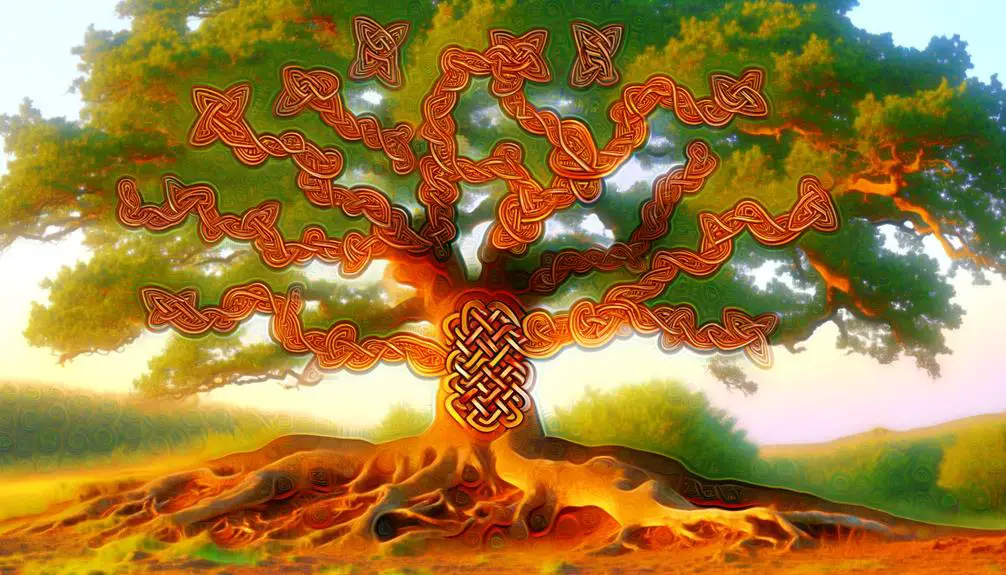
In parallel to the cyclical symbolism of spirals, the oak tree stands as a monumental emblem of strength and longevity within Celtic culture. Revered as the 'King of the Forest,' the oak symbolizes endurance and resilience, thriving for centuries amidst diverse environmental conditions.
The Celts believed that oak trees were sacred, often associating them with their powerful deities. The deep-rooted nature of the oak mirrored stability and a grounded existence, attributes highly valued in Celtic society. Its wood, durable and robust, was utilized in constructing homes and tools, further embedding the oak's significance in daily life.
This veneration of the oak underscores a deeper spiritual connection, where its enduring presence symbolized a perpetual cycle of growth, strength, and renewal.
The Triple Spiral: Past, Present, Future
Embodying the intricate interplay between time and existence, the Triple Spiral, or Triskele, is a profound Celtic symbol representing the interconnectedness of the past, present, and future. This ancient motif encapsulates the cyclical nature of life and the seamless flow of time. Each spiral within the Triskele signifies one of these temporal dimensions, reflecting the belief in their perpetual influence on one another.
| Temporal Dimension | Symbolic Representation | Cultural Significance |
|---|---|---|
| Past | Left Spiral | Ancestral legacy and wisdom |
| Present | Center Spiral | Current actions and choices |
| Future | Right Spiral | Forthcoming possibilities |
The Triskele's design underscores the Celtic view that understanding and honoring each phase is essential for holistic existence and new beginnings.
Butterfly: Transformation and Growth
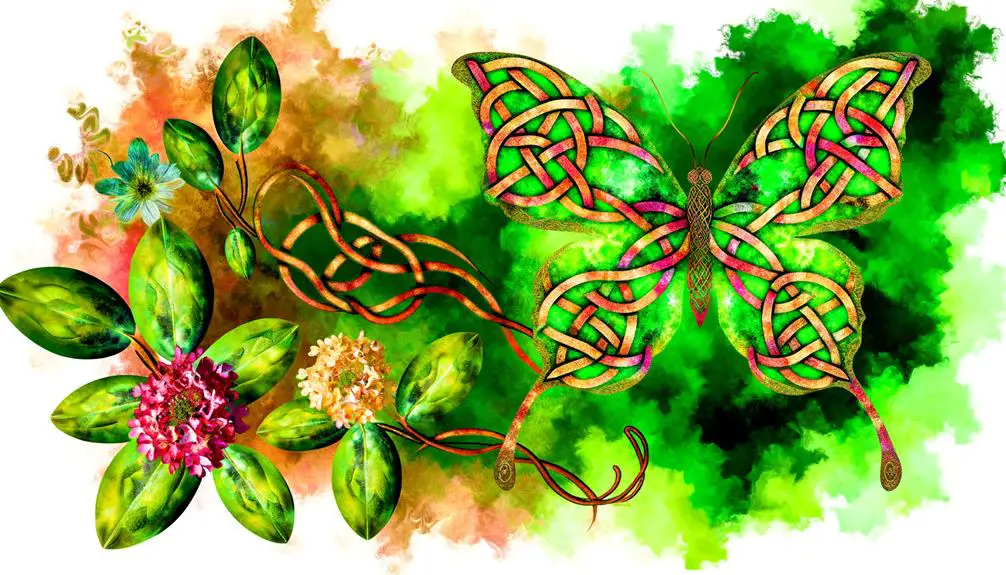
In Celtic symbolism, the butterfly epitomizes transformation and growth, representing the profound metamorphosis process observed in nature.
This emblem is intricately linked to personal rebirth journeys, capturing the essence of evolving from one life phase to another.
Symbolic Metamorphosis Process
Frequently revered across various cultures, the butterfly symbolizes profound transformation and growth, reflecting a symbolic metamorphosis process that aligns seamlessly with the theme of new beginnings. This metamorphosis is not merely a biological phenomenon but a deeply embedded cultural archetype.
The butterfly's life stages—egg, larva, pupa, and adult—mirror human experiences of growth and change.
Key elements include:
- Egg Stage: Represents potential and the inception of new ideas.
- Larval Stage: Embodies learning and self-discovery.
- Pupal Stage: Symbolizes introspection and preparation for change.
- Adult Stage: Reflects the realization and manifestation of transformation.
Understanding the symbolic metamorphosis of the butterfly provides a framework for interpreting personal and collective journeys of renewal and growth in various cultural contexts.
Personal Rebirth Journey
The butterfly's transformative journey from egg to adult serves as a potent metaphor for personal rebirth and growth, encapsulating the intricate stages of development and self-realization.
In Celtic culture, the butterfly symbolizes profound transformation, embodying the cyclical nature of life and renewal.
This metamorphosis, from caterpillar to chrysalis and ultimately to butterfly, mirrors the human experience of overcoming challenges to achieve enlightenment and new beginnings.
The butterfly's emergence from the cocoon signifies liberation from past confines, representing spiritual and emotional growth.
Conclusion
The exploration of Celtic symbols reveals deep cultural significance, encompassing themes of progress, inspiration, renewal, and transformation.
Each symbol, from the Triskelion to the Butterfly, embodies unique aspects of life's journey and cyclical nature.
This intricate tapestry of symbolism underscores the importance of understanding historical contexts and the enduring relevance of these ancient motifs.
Such anachronistic wisdom provides insight into humanity's perpetual quest for meaning, illustrating the timeless connection between past traditions and contemporary aspirations.


